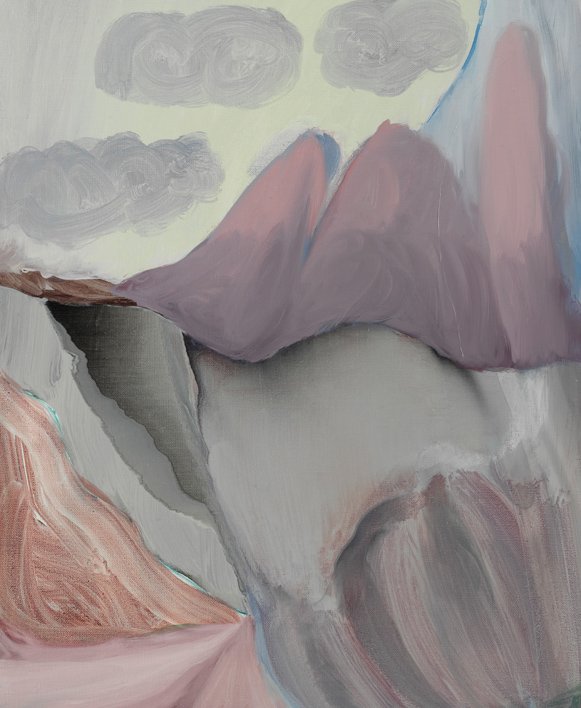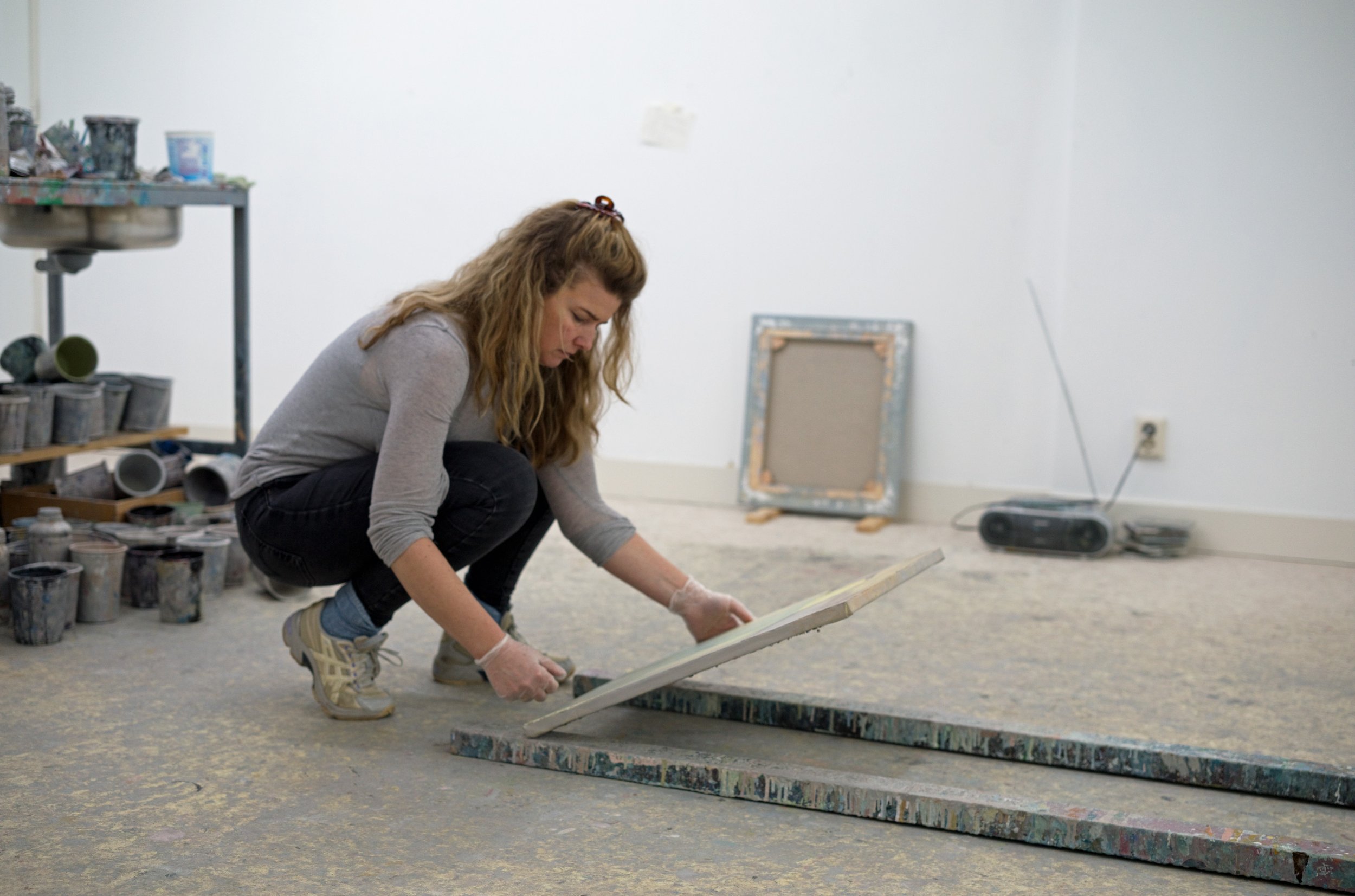
Rezi van Lankveld
Soft Sun
Elements of landscape, architecture, and the body meld together in the small-scale paintings of Rezi van Lankveld. Forms may look familiar but are reluctant to be identified in a singular sense; the figuration is ambivalent. Movement is key in the Dutch artist’s conception of a painting: a figure should be flexible and ready to change shape. At New York’s Petzel Gallery, van Lankveld presents recent paintings in the exhibition Soft Sun.
Rezi van Lankveld is known for the mode of painting that combines abstraction and figuration, chance and determination. She has shown extensively throughout Europe. Recent solo exhibitions include Office Baroque, Brussels, Belgium (2020); Reset, Borgloon, Belgium (2019); The Approach, London (2018); Annet Gelink Gallery, Amsterdam (2015); FIAC, Paris (2014); among others.
Van Lankveld’s work is included in the collections of the Stedelijk Museum, Amsterdam; The Rabobank Art Collection, The Netherlands; The Art Collection of the University of Chicago Booth School of Business, Chicago, and the Zabludowicz Collection, London and New York. Rezi van Lankveld graduated from Jan van Eyck Akademie, Maastricht in 1999. She lives and works in Amsterdam.
Interview by Jurriaan Benschop
Some of your paintings evoke aspects of a landscape: there are rocks, a sky with some clouds, or the slope of a hill. Do you think of landscape images when you make a painting? Do you have specific natural elements in mind?
Nature is there, but not in a direct, visible sense – more as a state of mind. The natural elements that I have in mind are abstract; they represent a movement or a certain depth. I grew up in a rural area in the east of the Netherlands, where the landscape was agricultural, with meadows, high skies, and also some forests. This spacious environment has helped form me.
Your work has a calm appearance, but it is also dynamic. It usually conveys a sense of movement, and this seems to be more important than the subject matter, the figure, or constellation that is depicted. The figuration seems ready to change its appearance. Are the motifs that you paint the result of intuitive gestures, or do you translate observations from life into the world of painting, following some sort of plan?
When I paint, I allow a lot of things to happen. I do not want to impose too much on the image as it unfolds. I do not use a sketch or anything like that in advance. A preconceived image would get in the way of my direct connection to the paint. I need the painting to keep changing once I start out, to find the right direction. In this process, I find shapes that seem uncertain about their identity. They could be this but also that – there is a dynamic quality in their appearance that I want to transmit. Often the final form of the painting comes in a flash – I see it at once. To reach that, the painting goes through a lot of stages, until the paint starts to become alive. Whereas in an illustration, the image tries to express one idea in precision, I look for the opposite, for openness and ambiguity. It is not just one thing that is depicted. It is rather a situation in movement. It is everything at the same time: figure, portrait, landscape.
Proximity, 2021, oil on canvas, 21.65 x 17.32 inches
Untitled (Support), 2021, oil on canvas, 19.69 x 15.75 inches
You look for openness, but the hints of figuration are important in your work. How specific does a painting need to be for you, in order for it to “work”? Does it need a relationship with the world as you can observe it? Or could it also be a fully abstract play of forms?
No, not an abstract play of forms. I work towards a form of figuration that is unnameable. I think that because I want it to be many things at the same time, it cannot be one exact thing.
Your palette seems reduced, subdued, as if you push back the colors and prevent them from becoming too shiny or frivolous. Do you know in advance how colors will develop? For instance, do you think in terms of tonality, contrasts, a certain light or atmosphere that you want to attain?
In my early works, my attention was focused mostly on light and dark, in a basic black-and-white ink drawing kind of way. I did not think much in color. In the series Soft Sun, you could say that there is a range from lower to higher color intensity. I still am highly focused on thinking about light and dark, but then I include colors that fit or support that thought. I use a lot of yellow because it gives light from within. White can take the light and suck it up, so I use that a lot, too. What makes the palette reduced is the fact that most colors are mixed and affected by each other. The paint is rather dirty in that way. I am not sure if I can ever make a frivolous painting as bright and shiny as a new car, because I don’t believe life is polished like that.
Some works, like Proximity (2021), seem close to the feeling of drawing. What role does drawing play in your practice? Does every painting start with a drawing? Do you collect ideas for works through making observational drawings?
While I don’t use drawings as sketches for the paintings, I do make sketches as a way of practicing shapes, to free my mind. Because it is faster than painting, it can catch images in between. The spontaneous quality that drawings can have is important; it is a quality I want to reach in painting, too.
Long Distance, 2021, oil on canvas, 19.69 x 15.75 inches
Comfort, 2021, oil on canvas, 23.62 x 16.93 inches
From a conceptual viewpoint, it seems that movement and ambiguity are at the heart of your practice. How does technique come into the process? The forms in your work have a natural appearance; things seem to flow as if it all just happens organically. But it is probably not that simple to make things look so easy.
No, but I am glad you think it looks easy. It is a challenging process, and there is a lot of failure along the way. If you work with improvisation, you dive into a process where there is not much to hold on to. That is the most exciting but also the most difficult part. There are highlights along the way that I might have to remove again. What drives me is the ambition to create an original, constructed image that looks like a natural thing. In some parts of the work, I pour paint onto the canvas, which puts the process into motion. It is the part that is untouched by the hand or brush, and it works like a natural phenomenon that becomes a given fact in the painting. I try to materialize the way I see things. In order to get there, I have to make constructional steps, but there are also moments when I need to step back as the author and let the paint do its work.
Globe, 2021, oil on canvas, 21.65 x 19.69 inches
Gossip, 2021, oil on canvas, 21.65 x 18.9 inches
How do you feel as a painter in the current context, where most people are used to the daily consumption of digital images? What is the drive to work with paint at this moment in history, also considering the abundance of photographical images that surround us?
What I value in painting is the physical aspect of it, the fact that you can see how something is made. It is real, there is a surface that you can enter and follow, there is nothing in between the viewer and the painting. For me it always feels like somebody is there, like a meeting in the flesh instead of on a Zoom call. Digital images are addictive – there is always the next thing. With a painting there is nothing else. It is a real encounter, and therefore it lasts.

“What I value in painting is the physical aspect of it, the fact that you can see how something is made. It is real, there is a surface that you can enter and follow, there is nothing in between the viewer and the painting.”
Passage (detail), 2022, oil on canvas, 19.69 x 15.75 inches
You speak about painting as an encounter. If you think of some other painters whose work you appreciate, do you feel that you can read their temperament in the work? Or how do you feel their presence in the work? Is it even desirable that the painter shows up in the work?
I am not sure if it is desirable. I suppose it could be different in other cultures, where the individual is not as celebrated, but of course every painter is present in the work even if they don’t want to be. It is like music: you like a voice or sound, and it makes you feel good, like there is an understanding. The encounter is abstract; it is about meeting through a shared language.
Soft Sun (installation view), Petzel, New York
Soft Sun (installation view), Petzel, New York
Rezi van Lankveld in her studio, 2021
Jurriaan Benschop is a Dutch writer and curator who is based in Berlin. He is the author of Salt in the Wound. Encountering Contemporary Artists across Europe (Helsinki, 2019) and contributed essays to many artist books and exhibition catalogs. Exhibitions that he has curated include A Grammar of Gestures (Athens, 2021-22), Young Americans (Thessaloniki, 2021-22), Taking Root (Düsseldorf, 2019-20), and A Matter of Touch(Berlin, 2020). He has been lecturing at art schools and universities in Los Angeles, Chicago, Detroit, Bloomington IN, Riga, Tallinn, Vienna, Helsinki, and other cities.
All images courtesy of the artist and Petzel, New York
Rezi van Lankveld
Soft Sun
Petzel
New York
February 16 — March 26, 2022








